One of my favourite places in Paris is the Palais Garnier, also known as the Opéra de Paris or Opéra Garnier. It is simply breathtaking! I am fascinated with The Phantom of the Opera so a visit to this opulent opera house was a priority. My wonderful husband offered to take me to the ballet; however, there wasn’t time in our agenda. We opted for a tour instead.
Main enterance
The Palais Garnier, constructed between 1852 and 1875, is the epitome of the love of splendour which prevailed during the Second Empire. The Palais Garnier was designed as part of the great Parisian reconstruction of the Second Empire initiated by Emperor Napoleon III, who chose the Baron Haussmann to supervise the reconstruction.
Auditorium
In 1858 the Emperor authorized Haussmann to clear the required 12,000 square metres (1.2 ha) of land on which to build a second theatre for the world renowned Parisian Opera and Ballet companies. The project was put out to open competition in 1861, and was won by the architect Charles Garnier (1825–1898). The foundation stone was laid in 1861, followed by the start of construction in 1862.
Wooden doors that lead into the boxes
The Opera was not opened until Jan 5th,1875 ~ Napoleon III, who was taken prisoner in 1870, was thus not able to perform this ceremony. Due to lack of finances and construction problems the work progressed slowly. An underground stream caused the excavated site to continually fill up with water and in the end it was decided to solve the problem by the construction of an artifical underground lake.
Balconies and the trompe d’oeil curtain ~
the interior of the auditorium is lined with gilded boxes on the dress circle and balcony levels.
Both above photos from Wikepedia: they show more detail of the curtain. Unfortunately, the curtain was taken down before our tour.
Grand Chandelier in the auditorium ~ is reported to weigh 6 tons. In 1896, one of the counterweights for the grand chandelier fell, killing one. This, as well as the underground lake, cellars, and other elements of the palais, inspired Gaston Leroux’s famous novel, The Phantom of the Opera. How I wish I could see this at the Palais!
The present-day ceiling decor of the auditorium is of more modern origin than the rest of the building. Marc Chagall painted the most famous figures from the history of opera in bright colors on a large plastic screen which was then hung below the original ceiling paintings.
The four sections of the painted ceiling over the Grand Escalier depict different allegories of music. At the foot of the staircase stand two bronze torchères, large female figures brandishing bouquets of light.
Ceiling of Grand Escalier
Statue at the base on the Grand Escalier
Balconies overlooking the Grand Escalier
Reptile on the Grand Escalier
Empress Eugénie, wife of the Napoleon III, is reported to have asked Garnier: “Whatever is this style? It’s not a style! It’s neither Greek, nor Louis XVI, nor even Louis XV!” Garnier is said to have replied, “No, those styles are outdated. It’s Napoleon III. And you complain?”
Marcello (Adele d’Affry, Duchess Castiglione-Colonna), Pythia, 1870 (installed 1875). Affry, who took the pseudonym Marcello in 1863 at her Paris Salon debut, was without question the most popular female sculptor working in Paris during the Second Empire.
Model
On the outside, the Palais is decorated with elaborate multicolored marble friezes, columns, and lavish statuary, many of which portray the deities from Greek mythology. Between the columns of the theatre’s front façade, there are bronze busts of many of the great composers, Mozart, Rossini, Daniel Auber, Beethoven, Meyerbeer, Fromental Halévy, Spontini, and Philippe Quinault.
Bach
Ceiling of the outdoor balcony
Although slightly smaller in scale than its predecessor, the Théâtre de l’Académie Royale de Musique, the Palais Garnier is a building of exceptional opulence. The palais seats an audience of 2,200 and has a huge stage with room to accommodate up to 450 artists. The style is monumental and considered typically Beaux-Arts, with use of axial symmetry in plan, and its exterior ornamentation.
Foyer
The vast and richly decorated foyers provide the audience with areas to stroll through during intervals. The vault of the avant foyer is covered with delightful mosaics in sparkling colours on a gold background. There is a splendid view of the Grand Staircase.
Foyer clock
Details in the foyer
Garnier intended the Grand Foyer to resemble the gallery of a classical chateau. The mirrors and windows accentuate its vast dimensions. The magnificent ceiling painted by Paul Baudry portrays themes from the history of music. The lyre, the dominant decorative element, is to be found on capitals, heating grates and doorknobs alike. A copy of Charles Garnier’s bust by the sculptor Carpeaux stands in the centre of the foyer, near one of the windows that look down the avenue de l’Opéra towards the Louvre. It’s no wonder the building became one of the most inspirational architectural prototypes for the next thirty years.
Statue in the The Salon du Glacier
At the end of the bar gallery is to be found the Salon du Glacier, a light and cool rotunda adorned with a ceiling painted by Clairin depicting dancing bacchantes and fauns, and tapestries illustrating different drinks (tea, coffee, orangeade, champagne…) as well as fishing and hunting. Completed after the opening of the opera house, this room has a very distinct 1900s flavour.
C’est Magnifique!
The Opera Garnier is located at 1, place de l’Opera, in Paris’s relatively central 9th arrondissement. Whether you see a performance or simply take a tour during the day, the Opera Garnier is definitely worth a visit.
The collections of the library-museum (Bibliothèque nationale de France) conserve a record of the three centuries of the Opera’s past. Throughout the year the museum presents short thematic exhibitions. It also houses a permanent gallery containing costumes, paintings, drawings, photographs and scale models of sets. The library-museum is situated in the Rotonde de l’Empereur, the west pavilion adjoining the main facade, originally destined for the Emperor’s use. After the fall of the Empire, building work was never fully completed and the dressed blocks of stone are still to be seen as they were in 1870.
Au Revoir! xoxo, B

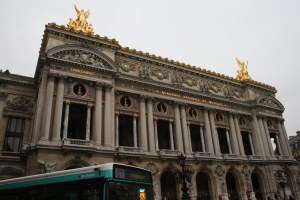


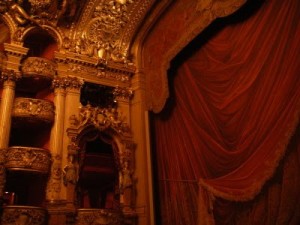
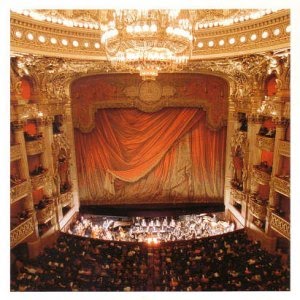

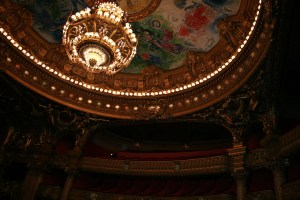


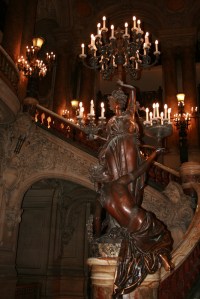
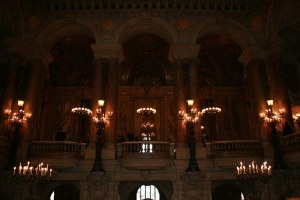
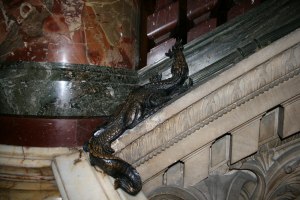
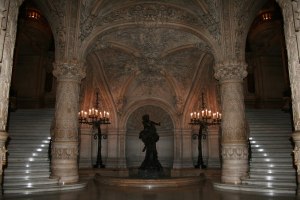
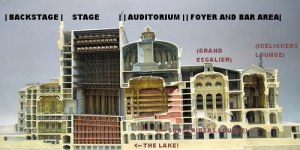
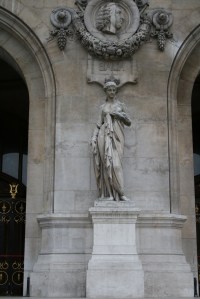



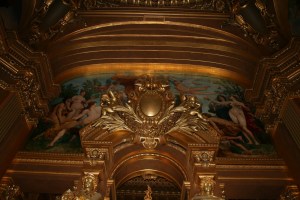

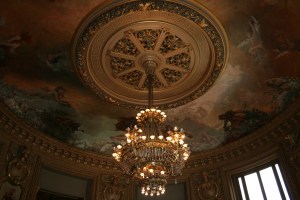


9 Comments
Bonjour ma belle! Oh, you have captured my heart…where all the beauty and art resides is here, in this hommage to art and humankind's contribution. MERCI!!! I attempted to create my own little Palais or Opéra; I have a little theatre that I constructed and I use it to compose my ideas for stories. Email me if you wish, and I will send you a picture of it!!
rivani@bethel.edu
How are you dear one? School has only three days left. I am so excited, just so that I can start my VACANCES!!! I hope that you will have a marvelous summer with your children. Bisous ma belle! Anita
Great post! You've captured all the beauty and interesting details of this lovely building.
Hope you're week is off to a good start,
Mimi
Just Magnifique,Heavenly post:-)*
These fabulous photos taken my attention very fast…The are totaly great ART!
And these history about the Opera theater building is new for me,thank you SO much for share!-)))*
Always with Love,
***Violetta***
Oh gosh! It is stunning! I've never been, but I'm longing to go there now and see a show!
Gorgeous history and pics, darling!
As a former architecture and art history student, I really appreciate this post!
xoxox,
CC
oh Brenda, I have never had the pleasure to attend an opera, I think this might have to go on my wish list of to do's….the beauty is breathtaking…still smiling Rosie
Thank you for the spectacular tour of the treasure of a building. I fell in love with it and now will make every effort to visit it to see all this beauty with my own eyes. Thank you so very much for sharing it with me!
So sorry for being absent for a while and being such a terrible Blog friend. Past few weeks were simply crazy between racing to Texas to get fabrics for upcoming collection, renovation of my house and day to day things in Atelier. It feels so wonderful to have a moment to visit my favorite Blogs and read fabulous posts just like this one. Have a very beautiful the rest of the week. 🙂
Hey dear Brenda,
It's F*R*I*D*A*Y….yippee
Hoping your weekend, is FULL of Sunshine…
Smile on Rosie…xoxo
Mon Ami … I have left a little treat for you on my blog. HHL